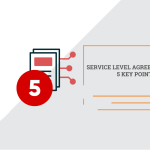Service level agreement (SLA) – 5 key points
Communication is the key to success. The purpose of any contract is to translate this communication into paper, to consolidate the main points of the agreement and to satisfy both parties. However, sometimes a misunderstanding arises between the parties when the client wonders “what I’m paying for” and the service provider does not understand the client’s “unreasonable requirements”.
The Service level agreement (“SLA“) is designed to solve this problem. This universal agreement can be used in many situations where the subject of regulation is the services of one party to another (for example, hosting, use of a software product, other IT support or informatization services).
In SLA, you can specify the terms of support and technical support, in particular:
- Support availability: SLA can set up continuous or fixed-term technical support, as well as availability times for other support requests, such as consulting, support chat, special requests, which usually coincide with business hours;
- Procedure for submitting and responding to support requests: SLA can regulate the procedure for submitting a support request and the maximum time required to respond to an incident or support request, as well as the time to resolve the problem itself, for example, the SLA can specify that the service provider must resolve a critical issue within 3 hours and a non-critical issue within 24 hours, with appropriate criteria for distinguishing between critical and non-critical requests;
- Performance indicators: SLA can define performance indicators that will be used to measure the quality of service, for example, it can specify that the service provider must achieve a certain level of network or server availability, which is measured by uptime monitoring tools;
- Measures taken to protect data: SLA may regulate the measures that will be taken to protect the security and privacy of the client’s customer data, such as data encryption, access controls to limit access to sensitive data, and regular backups to ensure that data can be restored in the event of failures, cyberattacks, etc.
- Liability of the service provider for failure to comply with the declared level of service: SLA may provide for consequences for the service provider for non-compliance with performance indicators. This may include pecuniary compensation, free or bonus services, refusal to pay for a certain period of service provision, reduction of the cost of services in the next period, or another liability model convenient for the parties; it is important for the service provider to record in this section the legitimate cases of absence of such liability.

What are the benefits of the SLA for the parties?
An SLA is a particularly useful tool for a service provider, as it can outline to the client the characteristics of the services to be provided that cannot be exceeded, especially if such services are priced differently – the client can clearly see what he or she is paying for and what he or she can expect for that price. Premium services cover a wider range of services, are delivered faster, better, to a higher frequency [insert the required criterion], and cost more accordingly. SLAs can also be a good way for internal administration of employees and checking the quality of one’s services.
For the client, the advantage is that he or she clearly understands what to expect from the service provider. An SLA can help ensure that the service provider delivers high quality services that meet the client’s needs. By defining performance indicators, the SLA provides a means to measure and evaluate the quality of the services provided. Failure to meet the specified standard results in the service provider’s liability. This type of liability is decided jointly by the parties.
By establishing clear parameters and defining communication and reporting tools, the SLA helps ensure that both parties are on the same page and can work together effectively. The SLA provides a framework for resolving issues quickly and easily and increases customer satisfaction. Indeed, customers are more likely to be satisfied with the services they receive when their expectations are met or exceeded.
5 key points of an SLA
Setting clear goals and expectations
This is the first and most important step in creating an effective SLA. Setting clear goals and expectations involves defining the services to be provided, the metrics to be used to measure performance, and the expected outcomes of the service. It is important to make sure that these goals and expectations are realistic and achievable, and that they are agreed upon by both the service provider and the client.
To set clear goals and expectations, the IT business must first understand the client’s needs and expectations. This stage sometimes requires involvement of technical specialists from both parties in addition to lawyers. The client should outline the problems and requirements to determine the key performance indicators that are most important to him or her, and the service provider should record them in the SLA in a clear and understandable form. Once this is done, the relevant service parameters can be defined, such as uptime, response time, and problem resolution time.
Division of roles and responsibilities
The second key point in creating an effective SLA is the division of roles and responsibilities between the service provider and the client. This includes defining the scope of services to be provided, the rights of the parties, and the responsibilities of each party. The SLA is not intended to exclusively impose obligations on the provider, as sometimes the client’s actions make the service rendering process difficult or impossible, which cannot be faulted on the provider. This step ensures that both parties clearly define what can be expected of each other and helps prevent misunderstandings and disputes.
When defining roles and responsibilities, it is important to be as specific as possible. This means outlining the tasks and responsibilities of each party, as well as the timeframe for completing these tasks. It is also important to define conflict resolution procedures to be used in case of disputes or if the SLA is not being properly fulfilled.
Determining the ways of communication
Effective communication is important in any business relationship and requires a detailed approach when it is addressed in the SLA. The client and the service provider should develop a communication plan that is convenient for both of them, which defines how the parties will communicate with each other, what channels they will use, and what information they will exchange. This information may differ from case to case. It is advisable to provide for informing about updates or changes in the system, the procedure for promptly resolving any issues that arise, and, in some situations, regular reporting on the provision of services.
Creating a contingency plan
The fourth key point in creating an effective SLA is to develop a contingency plan. Even if the parties make every effort to fulfill the SLA effectively, the possibility of force majeure or other situations that do not fit into the ideal “scenario” cannot be ruled out. Therefore, the client and the service provider are interested in developing a contingency plan for unforeseen situations, such as system failures, natural disasters, or cyberattacks. Such a plan should include steps to identify and respond to the problem, the procedure for notifying the parties of the contingency, and possible steps to minimize downtime and service interruptions. With a well-developed contingency plan in place, IT businesses can minimize the impact of unforeseen situations and maintain the trust of their clients.

Evaluating and reviewing the SLA
The last key point in creating an effective SLA is to periodically evaluate and review the SLA. This agreement is not intended to freeze the service level for decades, as the IT business and its products never stand still and are constantly evolving. Therefore, the service provider and the client should regularly review the SLA to ensure that it meets the current needs, capabilities, and expectations of both parties. Revisions may include adjusting performance metrics, updating the communication plan, or revising the contingency plan.
The process of analyzing and revising SLAs cannot be one-sided; the interests of one party must be matched by the capabilities and resources of the other. Therefore, updated SLAs should include input from both the service provider and the client. This ensures that any changes made to the SLA are agreed upon by both parties and are in their best interests.
Conclusions
The value of an SLA lies in its ability to provide a clear understanding of the responsibilities and expectations of both the service provider and the client. By defining the characteristics, criteria, and levels of services to be provided, the SLA helps to establish a mutual understanding of what is expected of each party. This can prevent misunderstandings and disagreements in the future, and create a strong, sustainable business relationship that will bring real value to providers and their clients. If you have any doubts about the obligations your client is asking you to accept, or if you are on the other side of the matter and doubt your provider’s guarantees, the best solution is to consult a lawyer and find out how the theory may work in practice.



